On Board Ship
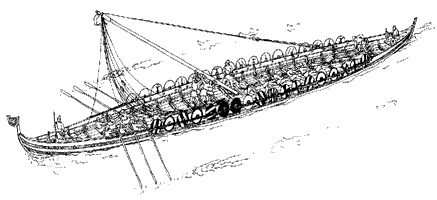
Hollywood is in love with the idea of rowing Viking ships. You can see why – it’s such a good visual look. Of course, all Viking ships were equipped with oars – there was no other way of propelling them if there was no wind, or if they needed to manoeuvre in harbour. The big beamy cargo ships would perhaps have two or three pairs of oarholes near the stem, and the same near the stern – the whole centre of the boat would have been taken up with the cargo. The oars would have been used only at the very first and last stages of the journey – leaving port and arriving at the destination. For a warship, the situation was very different. Battles at sea were, for the most part, boarding actions. Yes, arrows and javelins would be used, but the only effective way of dispatching an enemy was to close with him and board – as it was right up until the advent of gunpowder. Even in Nelson’s day boarding was a legitimate tactic, and if you go to see HMS Victory at Portsmouth you can still see the boarding pikes (we’d call them spears) around the masts. In a situation where you have to close with your foe, or flee from him, you can’t rely on the wind. Speed under oars would make the difference between life or death.
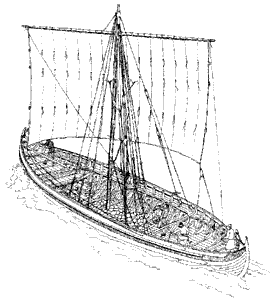
For the most part, Viking ships did rely on the wind. A cargo ship would have as few a crew as possible – the fewer on board, the larger each crewman's share of profit would be. The crews could (perhaps) hope to rely on the protection of a powerful patron, such as a King or a Jarl, to deter would be pirates. Certainly strong kings were eager to flush out havens of piracy such as the Kattegat and Skaggerak straits that guard the Baltic, and the Western Isles at the north of the Irish Sea. For warriors, ship time was (for the most part) a time to relax and conserve their strength. It was at their destination that they would need to do hard work. Games boards have been found scratched onto decks and chests of ships, and one particularly fine one has been found with pegs on it, just like a set of travel chess – giving perhaps a glimpse of how time was passed on board.
Of all the dangers that the Vikings faced, the biggest one has remained unchanged - the sea itself. All Viking boats were “open” – that is, there were no lower decks in which to shelter. Whilst this might make them uncomfortable in heavy weather, with a risk of hypothermia, there was an even greater danger – that of swamping. If the waves were high enough to come into the boat, it would fill very quickly with water, and with no airtight areas under the deck, even if the vessel did not capsize it would be almost impossible to save it from being broken up. One Scandinavian reconstruction of a Viking vessel has been lost this way – fortunately, thanks to modern search and rescue, with no loss of life. In Viking times, the dangers were even greater, and the chance of rescue almost non-existent. This is why we are very careful when we take our boats out!
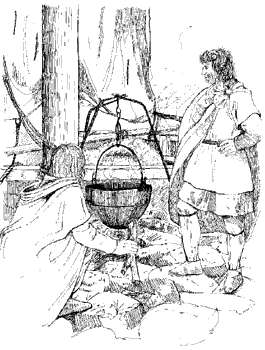
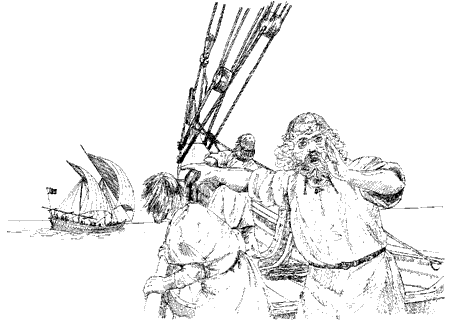
The Viking crew get a little panicky at the sight of an unknown Arab ship, which is in fact a trader just like theirs, with a crew who are just as panicky (right).
Sails and Rigging
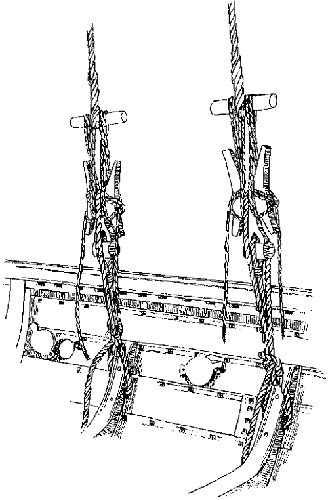
It was the sail that allowed the Vikings to make their great journeys of trade, raid, conquest and exploration. Unlike the hulls, no sails have been found from ships of the Viking age. However, some fragments from a 14th century woollen sail were found in a church in Norway. Since churches were often used to store parts for Longships (at least after the conversion to Christianity!) this seems a likely place to find a sail.
Wool seems a strange choice to make a sail out of at first. It has a lower strength to weight ratio than linen or hemp, both of which were available as well. However, made the way that the Vikings used it there are several advantages. It has a natural stretch, which makes it more efficient when sailing into the wind. The ability to stretch means that it is less likely to burst in a squall. The stretchiness of the sail also means that it can act as a shock absorber, softening sudden strain off the rigging. It has been estimated that making the sails and ropes for a Viking ship would probably take just as long as making the hull.
For the textile geeks, the yarn was from a “primitive” breed of sheep, such as the Vilsau; The warp of the weave contained the majority of the long hair of the fleece and had a hard, Z-spun twist, whist the weft contained the shorter hair and was softly S-spun. The fabric was woven into a 2/1 twill with between 8 and 9 warps per cm, and 4 to 6 wefts per cm. It was probably not fulled, but it was “smorred” – that is, it had multiple applications of animal fat and ochre rubbed into it. The animal fat would have preserved the sail, waterproofed it, and improved its wind-holding performance. The ochre would have helped with this, and also may have coloured the sail. The result is a fabric which weighs about 1kg per square metre, and has a texture described as “leather-like”.
Ropes on a ship are usually called “rigging,” and are usually categorised as “standing” and “running.” Standing rigging is the sort that is used to stop the mast from falling over – it’s designed not to stay put, and isn’t handled much. Running rigging is used to control the sail, and will thus be going through people’s hands all of the time. This makes the texture of the ropes very important – cut and rope-burned hands are no good on a ship, and ropes that jam in holes or pulley blocks are nearly as painful! Horsehair would have been the best rope to use for running rigging, as it is soft to the touch. Linen and hemp could also have been used. For the standing rigging, “bast” – the fibre found under the bark of the oak or the lime trees – could be used instead. The Halyard (the rope used to pull the yard, and the sail that is attached to it, up the mast) has to be the strongest rope on the ship. The very best were made from the hide of a walrus – not something that modern ships can boast!
The Sailors
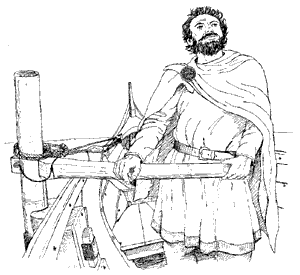
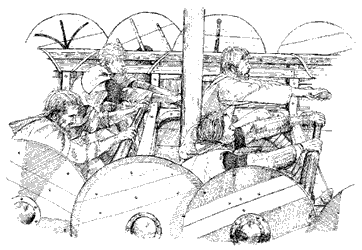
The sort of person that you would find sailing a Viking boat would depend on what sort of boat it was. The classic “raiding” boat would have consisted of a crew drawn from the middle ranks of society – the small landholders. One of the theories for the cause of the Viking age is an increase in the population of Scandinavia. With more people living in the same amount of land, there was less land to hand out; people would either have to face poverty and starvation, or search abroad for new opportunities.
Some of the Viking ships may have been communally owned. There is the tale of a French boat who tried to stop a Viking boat to speak to their leader. The response that came back was “that they were all equal!” At the end of the Viking age, Kings set up a levy system for home defence, where everyone in a town or village was responsible for the upkeep of a “local” ship; it’s thought that one of the Viking ships found blocking the entrance to Roskilde harbour was one of those. These ships would almost certainly never leave their home waters.
When the King or magnate wanted to go abroad, either for warfare or just to impress his neighbours, he would use his big Longships. These would be manned by his personal warriors, who would also be expected to know the rudiments of sailing. It was considered a noble achievement to be able to sail a boat. Depending on the size, a fully manned Longship could carry forty to one hundred people, so co-ordinating them would have been quite a feat of man-management.
No-one knows who owned the trading ships for sure. It may be that they were a communal effort from amongst several “well off” families in a geographical area, or that a local magnate would have had them built. The crews would have been much smaller than for a longship – perhaps eight to twelve people – as most of the space would have been needed for cargo. All would have been known to the owners, and perhaps they would have been expecting a share from the profits.
Controlling the Ship
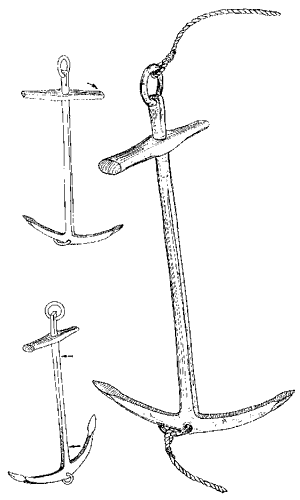
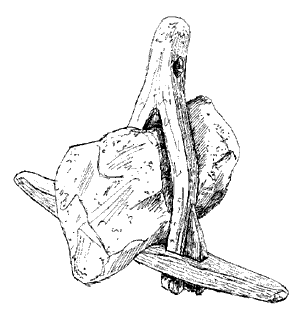

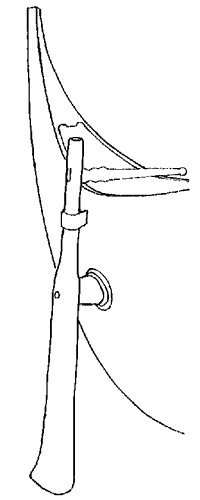
Related articles on this subject in Regiapædia
- 'Woodworking' - Anglo-Saxon And Viking woodworking techniques.